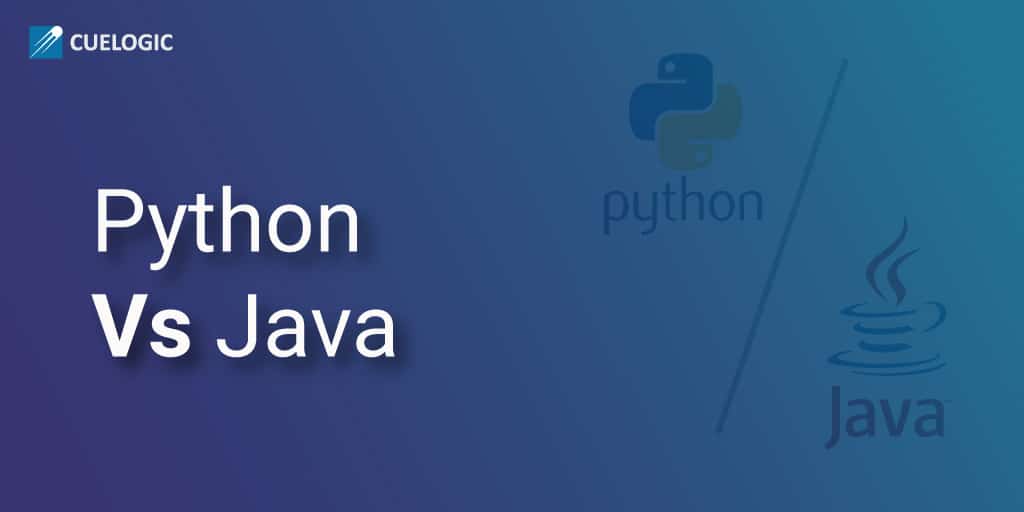Anatomy of Python and Java
Both languages offer something unique to the table. While they have their unique technical differences, they’re essentially fully developed languages that have thriving communities aiding in innovation. Both languages are written differently as well, as they’re utilized uniquely as per their running efficiencies. While one is extensively used for Machine Learning and Data analytics utilities, the other can be used to design great applications. Java is also an industry standard that can be used across various tech frameworks. It has an extensive code library that many developers can leverage to work off existing projects.
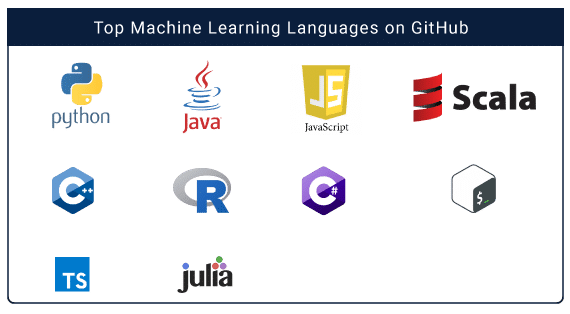
Java is also a standard in many applications designs as well. For dynamic coding and to have motion in action, Java is the preferred language. When it comes to Python, much of the server-side coding and the new web frameworks being launched work off python. Developers need to code in the right amount of code to develop Python, as it is a conservative language. Developers need to use less to describe more. This makes Python increasingly in-demand. Additionally, due to its popularity and versatility, Python is used across developing complex applications that leverage its capabilities.
From financial algorithms design to web parsing technologies, much of the coding in the world is done using Python. Python is an ambiguous language to master but a simpler one to code in when compared to Java. While Java is used more for client-side coding, Python can be implemented for server-side development. Both languages are designed to appeal to different requirements within the framework. Python is also powering much of what we see in the AI space.
“Contrary to popular belief, programming is not just a requirement to automate a trading strategy but is also required through most of the trading life cycle. With the rise of data sciences, Python has become the world’s most popular programming language in 2017-18, including in the financial markets.” – Nitesh Khandelwal – Co-Founder and Director QuantInsti (Algo trading finance)
Technical differences between Python and Java
While there are differences in the approach and adoption of the language, it’s important to understand the functional differences therein. From a scale stand-point, it’s critical to review the technical scope of Python and Java. Are there differences from a technology point of view? Yes, there are.
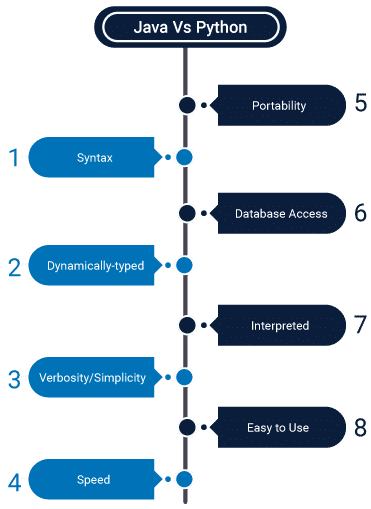
Performance
As the languages only have semantics, therefore to compare the speed of language choice of specific effectuation is important to be identified.
Popularity
Before the evolution of Javascript (ReactJs, AngularJs and NodeJs), Java was considered to be the most popular language of all. On the other hand, according to Github’s octoverse, Python is considered to be the most used language, and Java comes on the second position. 45% of the developers know about Java, whereas 39% only know about Python. As per the developer survey of 2018, Python is considered as the fastest growing computer programing language.
Web Development
Python and Java both are utilized in the backend web development where the developers build frameworks which is considered as an abstract software to construct the backend technology. The two commonly used frameworks are Django and Flask for Python. As a rather relatively less trending than Django, Spring is used as the framework for Java.
Code readability and formatting
Often the developers face confusion regarding which programing language should they choose for their upcoming projects amongst Java and Python. Python has sustained longer than the new languages and it is one of the fastest growing programming languages.
According to the language survey report placed by Digital Ocean, Python is accepted as the second best programing language for open projects. Also according to the index chart prepared by TIOBE, Java is categorized as the best programing language, and Python is regarded as the third-best programming language.
Regardless of all these numberings and ranking it can rest be assured that Java and Python are quite exclusive and strong languages with cross-platform support generation and standard librarian authorities. All of the particles are treated as objects by them. Python is generally compiled in runtime but both of the languages are run in bytecode. Amidst all these Oracle released a new model for Java.
In the specified case of code readability and formatting, the procedure is usually to open a large text box or text file and relatively collect every line into various sets of 50 comma-separated records. Through this mode of derivation, it has been noticed that the coding and formatting of Python are much linear and less dispersed which makes it relatively less difficult to apprehend. On the other hand, Java coding and formatting uses multiple extensions and the denotation, and reference points are broken down in several stages. Therefore, particularly for code readability preferences and formatting, developers prefer Python over Java.
Typing
The syntax used in Python resembles the commonly known English language. You can read the code and interpret it quickly. It does not take a highly advanced technical knowledge to understand the differences that Python is highlighting. Additionally, from a compliance stand-point Python remains compliant to all known entities, corporate policies, and guidelines for best practices in coding. Python is also regularly updated, which means that staying secure is now much more comfortable using Python. With regular updates and patches, companies can code better and faster.
Python is also a more natural language to learn from the ground up. It takes longer to master the style, but the core mechanics and coding requirements are quite simple to adopt. You can then create more nuanced frameworks based on that language for your specific project. You can also design the plan to be based on that framework for drag and drop functionalities. It’s the perfect language to deploy if you’re working with multiple teams and different ecosystems.
Java is statically typed, and Python is a dynamically typed. Names in the code are bound to strongly typed objects at runtime. There are minor challenges in legibility as the code is laid out. Python support is also differentiated into smaller communities working on the technology. While Java has been centrally updated, Python enjoys community-involvement and development. Both languages are compiled down to bytecodes that run on virtual machines as well.
When it comes to Java, there are various advantages to using the language. Java supports only one programming paradigm: object-oriented, giving it a clearer objective and use case. It is updated by one entity, and therefore the quality is maintained throughout. The added advantage is that when Java contains errors, it will just not compile. Coders can review their code again and create better models.
All developers know that Python’s database access layers are not as active as Java’s JDBC (Java DataBase Connectivity). This leads to the popularity of the language. From a technical standpoint, this is important to note, as it is one of the reasons why Java is massively prevalent in the developer community.
It is also known that Python is easier to use owing to its simpler language structure and syntax. It’s not that you can’t do as much with Python as you can Java. It’s that you can perform different objectives with either language. You can also develop applications that are more robust when you use both languages together.
Brevity
For both the languages, a blockage is created as soon as the declaration is commanded. The resourceful files and text boxes stay within the access. In the case of Python, as soon as the loop reaches the end it automatically gets out. While in Java the process is relatively compound. Here, a buffered reader is passed through a file reader and at the end of the file, the null files are rechecked and scrutinized. The Python demonstrations are clear, concise and transparent, whereas Java is relatively more tedious. Python is capable of running a script much easily and quickly, whereas Java demands the requirement of one entry point.
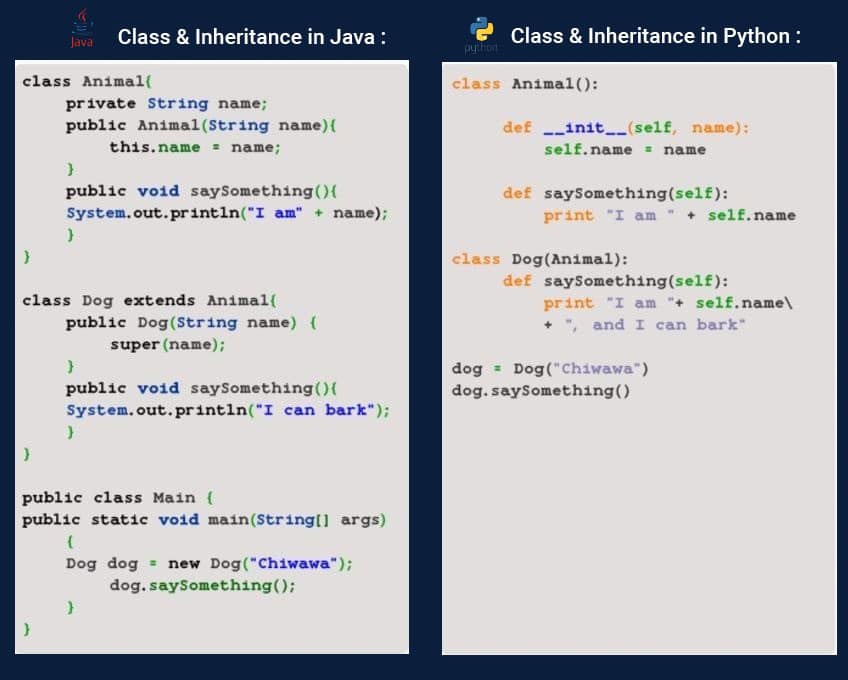
Python vs. Java Comparison Table
To summarise the above-mentioned differences, the following is a tabulated version of the major differences between Python and Java.
Topic |
Python |
Java |
Code | Generally, the coding procedures and inserted codes are comparatively much shorter and concise. | In the case of Java, the documentation of the code is quite longer than the usual. It is also definitely static and mainly void compared to Python public Class. |
Syntax | Indention is extremely necessary for Python as it helps in reading the code more clearly and distinctly. Apart from that, the statement in Python can end anywhere without even a semicolon. | Generally, curly braces are utilized to create some particular blocks in Java. The coding does not materialize without it. On the other hand, Java displays an error if no semicolon is used after the conclusion of a statement. |
Dynamic | Python goes through the process of duck typing, where the variable type is not at all necessary to mention. Therefore it is considered that these codes are dynamically typed. | Java won’t be working if you don’t address the data type in the midst of the phase. |
Speed | Python helps to interpret as well as the identification of the datatype is conducted in the runtime. Thus it is noted as a language with low speed. | Java is swifter, smarter and faster. The best in the market when speed is concerned. |
Portability | The portability of Python is not as good and popular as compared to Java. | The sign of Java’s relatively high portability is its virtual machine which is obtainable from anywhere. |
Database | Enterprises do not approve the use of Python databases as the access layers are quite feeble as compared to Java. | The database connectivity of Java is quite strong and popular. |
Ease of Usage | Because of the dynamic coding and indention, Python’s coding is easy to understand and comprehend. | Java is comparatively much harder to use due to the absence of dynamic programming. |
Practical Dexterity | Python includes data science and operational management, which makes it sustainable in the talent space. | Due to the presence of Java’s static system mechanism, it attracts as well as obtains uninterrupted support which is refactored. |
Legacy | The legacy issues adjoined with Python is comparatively less, that is why institutions find difficulty in coding. | The legacy structure of Java is bigger and legion in comparison to Python, therefore the coding style is comparatively tedious. |
Industry Demand for the Languages
We’re seeing increasing demand from the industry with regards to which language is being used where. While both languages are equally popular, Python is taking the lead regarding modern innovation. Python has the flexibility to be used across various projects and schemes of design. It can also be used as a precursor to much of the innovation we see in the Machine Learning space. There are also advantages to having Python be integrated across the board, as well as be leveraged by multiple organizations across different industries.
Python can be used to design the most sophisticated apps and Machine Learning algorithms that you have seen. It’s also coding much of the world’s innovation, regarding IoT processing and database management. Python can also be used as a bridge for many different applications that rely on multiple languages to be run across different systems.
Added to that, since Python has variants of both C and Java, there is some flexibility offered there. CPython and Jython are commonly used across various platforms to provide similar levels of efficiencies as the languages mentioned above. It’s a great way to design a comprehensive program that relies on these core languages. Much of the innovation provided by the open source language has been developed by core tech companies like Google and Facebook. These companies have refined the language and developed complicated designs that go off the core language.
Python is generally known as the Swiss Army knife of the coding world, due to its versatility and flexibility in use. That’s why it has become increasingly popular over time. Companies can adopt Python to perform some uniquely complex processes over the long-term.
Java, on the other hand, is the perfect language to deploy when working with client-side experiences. It’s the right language to work with when developing applications and software integration. Technologies such as Blockchain and smart contracts are benefiting from the mainstream adoption of Java. Java has been in the market for decades now, with upwards of 3 billion devices using the core language. From a popularity standpoint, Java is in a unique place. The market requires the offerings provided by Java.
From IoT to ID technology, Java runs across these platforms as the backbone of the integration. Java has enough flexibility to incorporate much of the requirements within the industry. Java has been used for web development and design projects that integrate motion graphics. Java also deploys across various mobile and web apps that need complex coding. From a logic and learning stand-point, Java is a unique language used widely. The core philosophy of write-once and run-anywhere is a valuable add-on which has contributed to the rise of the language.
Some of the largest companies in the world like Airbnb, Uber, and Amazon deploy Java’s capabilities to create memorable experiences. It’s one of the most robust languages to ensure positive outcomes, especially when it comes to designing consumer-friendly applications. From a dynamic website to a multi-functional app, Java is a higher language to create your product in.
Java is also fuelling much of the connected devices that are in the marketplace. Everyone remembers the iconic Amazon Go button that can be pressed to order groceries automatically. Additionally, Amazon’s self-check-out process is also designed using Java extensively. When it comes to connecting the digital and physical world, it’s essential to use Java for your programs.
Innovations in Python and Java
Kite is a newly launched framework that is developed off the core Python language. It’s perfect for deploying across ML and AI programs. It recently raised $17M for its AI-driven code completion tool. It aims to use ML and AI to reduce the burden on developers.
“That’s why [developers] spend so much time on Stack Overflow. That’s why they spend so much time debugging fundamental errors and looking up documentation, but not so much time looking at how the solution should work. We thought we could use machine learning to fix that.” – Adam Smith, Founder Kite.
Kite is one of the main innovations to emerge in Python that is helping developers to write better programs. Its aiding developers to write some of the best code that they can. It’s also shifting our perspective in the domain of Python, especially in the case where development needs to be done in a lean manner.
Python is also being used in much of the Machine Learning and Artificial Intelligence packages. The flexibility that the language offers is unparalleled. Google’s open source TensorFlow is also one such popular framework that leverages the capability of the language. It democratizes machine learning in a significant way and creates greater avenues of development and exploration.
Even Amazon SageMarker is converging with Jupyter Notebook and Python to create a more comprehensive program. This is aiding Big Data to come to fruition, along with sharing new insights that can emerge from analytics. Additionally, Python is creating innovation in the NLP space as well, as more complex algorithms need greater data sources to pull information from. The architecture can be designed using Python, especially when it comes to creating a robust model that relies on multiple inputs. Python can be innovated upon from various organizations.
Java sees updates and innovations on a smaller scale. The language is used extensively across various industrial applications and especially in the B2B space. That’s where a lot of companies hire Java developers exclusively to design complex projects. The processes necessary to develop these projects require Java extensively. Java is also leveraged widely to create quality applications that are innovative in their approach. Java is designed to improve efficiencies in the design process.
It’s important to understand where Java is heading from a language perspective. This will enable us to get a clearer idea about how scalable the language is. With the emergence of EE4J and MicroProfile Projects, Java has become a recognized language that allows greater flexibility in the coding domain.
“MicroProfile is a set of specifications for doing Java microservices, and that community has done a great job in really bringing forward a lot of new specifications and doing it quickly. We’re now seeing real multivendor engagement around micro-profile, and we’re seeing lots of people showing up in conferences in talks about it, so there’s a lot of interest out there around this technology. MicroProfile is setting us up for having more success for Java in the microservices area. The migration of critical Java applications into the cloud is only going to accelerate, and we think MicroProfile could be a big part of that.” – Mike Milinkovich, Executive Director of the Eclipse Foundation.
Kotlin has also aided in the advancement of mobile and Java development, along with providing the essential framework for increased innovation in the space.
When it comes to VR/AR and interactive technologies, Java can be used as a viable solution for development and design. While Java is being used extensively across industries, its real potential is unlocked by scale-driven applications. Java’s extensive reach is best seen in enterprise cloud apps that are designed to perform multiple functions. From increasing core security to designing better compliances, Java is used across a multitude of innovative applications.
Potential of the languages
There is massive potential in both languages, both from a technological and growth standpoint. Each approach is unique and beneficial to the greater business community. Additionally, when you have two massive languages such as Java and Python, you want to leverage their core to the maximum potential.
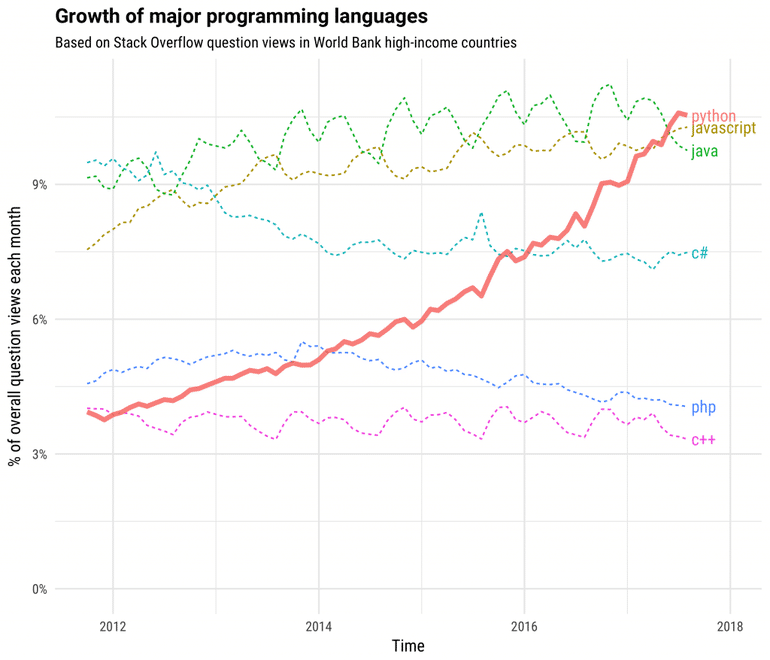
E.g., if you have an app that leverages AI, then you need to use both languages to design the outcome. You also need to find a way to enhance your Machine Learning offering before entering the domain, which is going to require a thorough understanding of cross-functional coding. Full-stack developers may be used here, but experts are also recommended across the board.
Java has massive potential in the client-side and customer-facing domain. The language can be used to code complex applications that can be scaled up to millions and billions of consumers. Many of the world’s biggest apps are being designed using Java. Python is dynamically interpreted, with Java leveraging more efficient coding architecture. There are also extensive libraries available to developers that want to enhance their skill set. Statically typed languages like Java are naturally faster, producing more efficient code across the board.
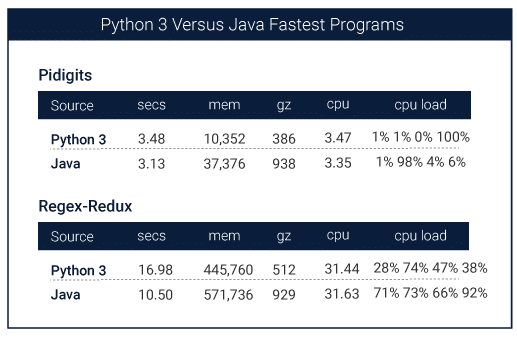
This has opened up space for Java to flourish and take over in a sense. The language can be used extensively to code some of the most complex applications worldwide. Java is also used by 90% of Fortune 500 companies and is being leveraged across the tech sphere as well. While many talks about the security bugs that can enter via Java, they’re not taking into account the vast number of applications that run the technology. It’s a robust and scalable solution that can be used to design applications under any capacity.
When it comes to Python, it’s one of the more popular languages in 2019. This is because the scope for Python has expanded to include some of the most dynamic projects that you can code. Python has the capabilities to run complex algorithms and logic-based applications that can be developed to compute exciting innovations. Machine Learning, Data intelligence, and AI have used Python extensively to code some of the more unique applications.
Industries that rely heavily on Python are also those that are running multiple applications within the program. This has made Python increasingly popular, owing to its compatibility across domains. In other words, you need Python to code many innovative and potential-bound applications. You can also create new avenues of development using Python, especially when it comes to apps that work on neural networks. Because Python supports multiple coding paradigms, it can be used for scale-driven applications easily.
“Python is an unusual case for being both one of the most visited tags on Stack Overflow and one of the fastest-growing ones. Incidentally, it is also accelerating. Its year-over-year growth has become faster each year since 2013. We make the case that Python has a solid claim to being the fastest-growing major programming language.” – David Robinson, Stack Overflow Data Science Dept.
For developers looking to enter the domain of AI, ML, NLP or advanced computing, Python offers more significant rewards. Developers working on Python also earn more than those that work on Java exclusively.
The importance of being multi-language oriented
For large-scale projects or even small integrations, having a rough idea about the other language is critical. It helps in becoming more full-stack oriented and handling the more complicated process. The biggest challenge in the development community at this point is the lack of understanding of the other language. Full-scale communities are being developed that lend to the overall process of either’s development.
However, what developers need to understand is the importance of the other’s existence. It’s critical also to gauge the frameworks present in either language. You don’t need to understand Python or Java fully to leverage the right structure required for the job. This makes projects that require complex coding easier to break down. When developers have an understanding of the objectives of each frame, it becomes simpler to execute.
When you take a multi-language approach, you start to focus on the objectives of the code rather than which coding mechanism to adopt. Additionally, from a framework perspective, there are more options available when you take different languages. You can create a broader scope for your project and design a more robust system. There are challenges with staying consistent with the only word, which you may come into when your project scales up.
Conclusion
While Python and Java are two of the most robust languages out there, the differences couldn’t be more significant. Both languages are designed for specific functionalities and can be leveraged across various parameters. As they’re used extensively across domains, they have a greater impact on the overall dynamic of their coding environment. While Java is a statically typed and Python is a dynamically typed one, both languages offer benefits that are invaluable in the industry. Java is a compiled language, and Python is an interpreted language. While there are many differences across the board, developers need to be proficient in both coding environments. Projects may call for both languages to be fully explored, and they’re some of the most desirable skill sets to have in 2019.Must Reads:
[wcp-carousel id=”10009″]
